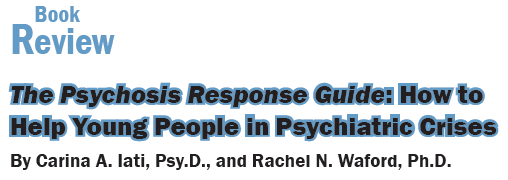Book Review: The Psychosis Response Guide

 The Psychosis Response Guide by Carina Iait and Rachel Waford was written to share information with folks who may encounter a young person experiencing psychosis. But it does so much more. It not only teaches the reader about psychosis—what it looks like, how to react to it—but it also humanizes the people struggling with that experience. It simultaneously empowers and educates, thus reducing the fear and anxiety of encountering this challenge, for all potential helpers.
The Psychosis Response Guide by Carina Iait and Rachel Waford was written to share information with folks who may encounter a young person experiencing psychosis. But it does so much more. It not only teaches the reader about psychosis—what it looks like, how to react to it—but it also humanizes the people struggling with that experience. It simultaneously empowers and educates, thus reducing the fear and anxiety of encountering this challenge, for all potential helpers.
Insightful and timely guiding questions encourage the reader to consider what it might be like to endure aspects of psychosis. These questions are also designed to help the reader roleplay the helper’s experience. The authors provide valuable information about verbal/nonverbal cues, communication strategies, and empathy, and then ask the reader to increase their self-awareness and consider how they might want to present themselves to an individual in distress.
Vignettes are also provided. The authors guide the reader through noticing symptoms, the common responses of loved ones, the young person’s reactions and the approach used, as well as next steps taken by the helping individual. These examples allow the reader to begin testing their newly developing skills—to think about how they would see those behaviors now that they have some understanding of psychosis, and to consider what they would say and do.
The book then offers the reader support in understanding how they would go about making such decisions. Rather than relying on the individual—newly familiar with the symptoms of psychosis and some communication strategies—to make do with just these tools, the authors help the reader develop a list of “check-downs.” These checkdowns empower the reader to evaluate their intervention options; first, by identifying specific aspects of the situation to consider and then, by naming those options.
The final chapter aims to help the reader understand what to do following an intervention, based on their own emotions and relationships, as well as on the needs of the young person in distress. It is a unique but essential chapter that validates the helper’s likely difficult experience and identifies potential outcomes and options for follow-up, before offering a plethora of national resources to help young people in psychiatric crises.
The Psychosis Response Guide is a book that all professionals working with adolescents and young adults should read, and one that is both as accessible and enjoyable as it is educational and empowering. The book can be found on Amazon and Springer Publishing websites.
Book Review by Dr. Lynn Coleman, a clinician at Desert-Heights Academy, a school in Phoenix serving children and adolescents coping with emotional and behavioral challenges.
